Topics
Historiography : Development in the West
History : Applied History
Working of the Constitution
Historiography : Indian Tradition
The Electoral Process
Political Science : Working of the Indian Constitution
Applied History
Political Parties
History of Indian Arts
- What is ‘Art’?
- Indian Traditions of Visual Arts (Drik Kala): Painting
- Prehistoric Paintings
- Mural Paintings and Cave Painting
- Folk Styles of Paintings
- Classical Styles of Painting
- Miniature Paintings in Manuscripts
- Modern Indian Paintings
- Indian Traditions of Visual Arts (Drik Kala): Sculpture Art
- Indus Civilization Sculpture
- Folk Styles of Sculptural Art
- Classical Styles of Sculptural Art
- Indian Iconography
- Indian Traditions of Visual Arts (Drik Kala): Architecture and Sculpture
- Rock-cut Architecture
- Temple Architecture
- Indo-Islamic Architecture
- Indo-Gothic architecture
- Indian Traditions of Performing Arts
- Indian Theatre
- Indian Music
- Indian Dance
- Present Scenario of the Performing Arts
- Art, Applied Art, and Professional Opportunities
Social and Political Movements
- Movement
- Important Movements in India
- Tribal Movement
- Farmers Movement
- Worker's Movements
- Women’s Movement
- Environment Movements
- Consumer Movement
Mass Media and History
Challenges Faced by Indian Democracy
Entertainment and History
Sports and History
Tourism and History
Heritage Management
History - Imperialism
History - 20th Century Age of conflict
History - Emancipation of Asia and Africa
History - World after World War 2
Political Science
Geographical discoveries and colonization
- Concept for Geographical Discoveries and Colonization
Africa
- Imperialism - Africa
Asia: India, China, Japan
- Concept for Asia: India, China, Japan
Dictatorships in Europe, Second World War and world
- Concept on Dictatorships in Europe
- Concept for Second World War and World
First world war
- Concept on First World War
The League of Nations
- Concept for the League of Nations
Russian Revolution
- Concept for Russian Revolution
United Nations Organization
- Concept for United Nations Organization
Africa
- Emancipation of Africa
Asia
- Emancipation of Asia
Globalization
- Globalization After World War II
Scientific and Technological Progress
- Scientific and Technological Progress After World War II
Cold war
- Formation of the Cold War
Social Diversity and Democracy
- Social Diversity
- Coccept for Caste/Race and Democracy
- Concept for Language and Democracy
- Cocnept for Religion and Democracy
- Concept for Gender and Democracy
- Concept for Democracy and Diversity
Challenges to Democracy Remedial Measures to the Challenges
- Concept for Challenges to Democracy Remedial Measures to the Challenges
Internal work
Democracy
- Democracy - Meaning, Types and Characteristics
Political Parties and Types
- Political Parties
- Importance of Political Parties
- Major National and Regional Parties in India/ Types of Political Parties
- Puppetry - Wooden Puppets (Kathputali)
- Dashavatara Theatre
- Bhajan
- Keertan
- Lalit
- Bharud
- Tamasha
- Powada
Notes
Folk Theatre:
- Folk theatre is a fantastic style of story-telling in which one or more actors use their talents for dancing, acting, singing, talking, miming, and theatre crafts like masks, make-up, and costumes to bring to life a fictional world for the audience.
- Folk theatre is an indigenous tool used to spread critical social, political, and cultural issues in the form of theatrical messages in order to raise public awareness.
- The folk theatre, which has its roots in native culture, is deeply ingrained in local identity and social values.
1. Puppetry - Wooden Puppets (Kathputali):
- A puppet is a doll or figure representing a person, animal, object, or idea and is used to tell a story.
- Remains of clay dolls have been found in the excavations of archaeological sites of the Harappan civilization as well as sites in Egypt and Greece. It is possible that they were used as puppets.
- The puppet is made of various materials like wood, wool, leather, horns, and ivory which can be moved in different ways.
- Kathputali, a traditional art of puppetry in India has two styles; one that developed in Rajasthan and the other in southern regions of India.
- The artists who stage Kathputali shows are found in Uttar Pradesh, Maharashtra, Rajasthan, Assam, West Bengal, Andhra Pradesh, Telangana, Karnataka, and Kerala.
- Puppets are classified as follows on the basis of the way they are moved in performance:
1. String puppets
2. Glove puppets
3. Rod puppets
4. Shadow puppets
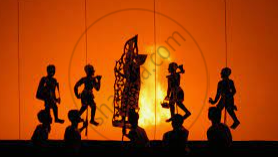
Shadow puppets, Andhra Pradesh
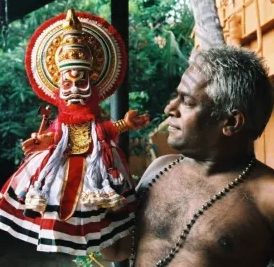
Glove puppet, Kerala
2. Dashavatara Theatre:
- Dashavatara is part of the folk theatre in Maharashtra with an eight-hundred-year history.
- The ten incarnations of Lord Vishnu, the Hindu god of preservation, are referred to as dashavatars. Matsya (a fish), Kurma (a tortoise), Varaha (a boar), Narasimha (a lion-man), Vaman (a dwarf), Parashuram, Ram, Krishna, Buddha, and Kalki are the 10 incarnations.
- Dashavatara shows are presented in the regions of Konkan and Goa after the harvesting season is over.
- At the beginning of the show sutradhara, the narrator invokes Lord Ganesha, the destroyer of obstacles. Dashavatara performances follow a fixed pattern for acting, makeup, and costumes. While there may occasionally be a few unexpected conversations, the event is primarily musical. Wooden masks are worn by the people who play the gods. Dahihandi, an earthen pot of curds, is broken at the end of the performance, and then there is aarati, or singing of God's praises.
- A phad (troupe) of Dashavatara performers was founded in the 18th century by Shyamji Naik Kale, and they used to perform throughout Maharashtra.
- The founder of Marathi theatre, Vishnudas Bhave, presented mythical plays by making minor adjustments to the Dashavatara style. As a result, the Dashavatara tradition serves as the foundation for Marathi theatre.
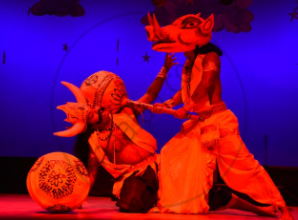
Dashavatara Theatre - Varaha Avatar
3. Bhajan (singing devotional songs):
- Bhajan is the practice of singing songs in praise of God and chanting his name while backed by instruments such as taal (cymbals), mridangam, and pakhavaj.
- There are two types of Bhajan.
(i) Chakri Bhajan: Devotees continue to move in a circular motion and sing continuously.
(ii) Songi Bhajan: The singer-actors portray devotees and speak dialogue through songs of worship.
(iii) Khanjiri Bhajan, a new variety of Bhajan, was introduced by Tukadoji Maharaj. - The bhajans written by Saint Tulsidas, the famous poet Surdas, Saint Meerabai, and Saint Kabir are well-liked throughout north India.
- Karnataka songs are performed using compositions by Purandardas, Kanakdas, Vijaydas, Bodhendraguruswami, Thyagaraj, and others.
- The Bhakti movement gained pace in Gujarat thanks to Saint Narasi Mehta.
- Saint Namadeva promoted bhajan-keertan in Maharashtra through the Varakari sect's history. Bhajan-keertan became a famous custom among the Varakari sect.
4. Keertan:
- Naradmuni is supposed to be the founder of the Keertana tradition.
- Keertan is performed in a temple or in the precincts of a temple.
- Saint Namadev is known as the first keertankar of Maharashtra. Other saints helped the tradition to flourish.
- The keertankar is also referred to as Kathekaribuva or Haridas. He must wear traditional clothing. He must develop his speech, singing, musical instrument, dance, and humour skills. He must be really knowledgeable.
- There are two main traditions of keertan.
(i) Naraadiya or Haridasi - Solo performance
The Poorvarang is composed of three parts:- Naman (praise of God),
- Nirupanacha Abhang (singing a song that introduces the main topic),
- Nirupan (explanation of the main theme).
Uttarrang is the story that is told to illustrate the major concept.
(ii) Varakri - Collective participation - Along with the keertankar, the singers of cymbals play a significant role.
- Rashtriya Keertan, a new variety of Keertan, was created during the independence movement.
- It emphasizes raising awareness more by describing the lives of outstanding Indian independence struggle leaders, scientists, social reformers, etc.
- Dattopant Patwardhan of Wai in Maharashtra is credited with starting the Rashtriya Keertan tradition.
- Keertan was also utilized by Satyashodhak Samaj members to raise social awareness, which was founded by Mahatma Jyotirao Phule.
- The Keertan style used by Saint Gadge Maharaj was quite similar to the Satyashodhak technique. He used to shed light on topics like eliminating caste, maintaining hygiene, ending drug use, etc.
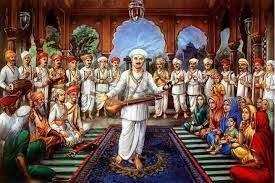
Varkari Keertan
5. Lalit:
- In Maharashtra, Lalit is a traditional form of entertainment. It is a part of the Naradiya Keertan tradition.
- In Goa and the Konkan, it is extremely popular.
- It is said that the festival's main deity is present during the performance of Lalit on the occasion of religious festivals, and she is then called upon to grant a wish.
- The Lalit is presented in a theatrical manner. During the play, stories of Krishna, Rama, and prominent devotees are given. There are several Lalit literatures that are also available in Hindi. The environment for the present Marathi theatre includes Lalit.
6. Bharud:
- Bharud could be considered a poetic song with moral and religious implications.
- Bharud has a look and feels similar to road performance. Saint Eknath's bharuds are well-known in Maharashtra due to their variety of subjects, dramatic quality, simple rhythm, and humour.
- Bharuds were written by Saint Eknath with the intention of educating people on different aspects of life.
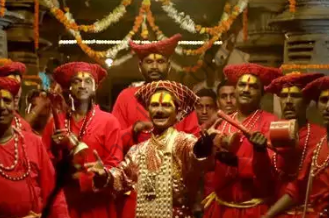
Bharud
7. Tamasha:
- The word "Tamasha", which refers to performance or other theatrical performance, is a loanword from Persian, which in turn borrowed it from Arabic.
- In the 18th century, Tamasha evolved into a distinct art form by adopting numerous elements of folk theatre and classical arts.
- Traditional Tamasha comes in two different forms:
(i) Sangeet Bari - Music and dance take priority above acting.
(ii) Dholakicha Phad - - Tamasha was later developed, with drama serving as the primary component. Vag, the dramatic component, was added a little later. Due to its unplanned humour, the Vag becomes very vibrant and engaging.
- The show opens with a song in honour of Lord Ganesha, sometimes referred to as Gana. The presentation of Gavalan follows. The Vag is introduced in the second chapter of Tamasha.
- Popular plays like Vichchha Mazi Puri Kara and Gadhavache Lagna are examples of the present form of Tamasha.

Tamasha Performance
8. Powada:
- Powada (ballad), which alternately recites poetry and prose passages, is a dramatic narration.
- Powada tells powerful and uplifting stories of amazing achievements performed by brave men and women.
- The Powada written by Adnyandas, a poet who lived during the time of Chhatrapti Shivaji Maharaj, and another one written by Tulasidas on the fight of Sinhagad is two well-known examples of Powada.
- Powadas were written during the British era to tell the stories of Mahatma Gandhi, Umaji Naik, and the Chapekar brothers.
- Powadas were utilized to raise public awareness during the ‘Samyukt Maharashtra’ movement.

Powada
Related QuestionsVIEW ALL [14]
Read the following extract and answer the questions below :
|
Dashavatara Theatre: Dashavatara is part of the folk theatre in Maharashtra. Dashavatara shows are presented in the regions of Konkan and Goa after harvesting season is over. The stories presented in these shows are based on the 10 incarnations of Vishnu, namely Matsya, Koorma, Varaha, Narsimha, Wamana, Parashurama, Ram, Krishna, Buddha and Kalki. At the beginning of the show Sutradhara, the narrator invokes Lord Ganesha, the destroyer of obstacles. The method of acting, make-up, costumes in Dashavatara shows is set by the tradition. The show is mostly musical but sometimes there may be a few spontaneous dialogues. The characters representing gods use wooden masks. The show ends by breaking dahihandi, an earthen pot of curds, followed by aarati, singing praises of the God. In the 18th century Shyamji Naik Kale started a phad, of Dashavatara artists which used to perform all over Maharashtra. Vishnudas Bhave, the pioneer of Marathi theatre staged mythological plays by introducing some modifications in the Dashavatara style. Thus, the origins of the Marathi theatre can be traced to Dashavatara tradition. |
- In which state Dashavatara is part of folk theatre?
- To whom the narrator invokes at the beginning of the show?
- The form of Dashavatara folk theatre. Explain.
Complete the following table:
| Lalit | Bharud | |
| Characteristics | ||
| Example |
Complete the following chart.
| Bhajan | Keertan | Lalit | Bharud | |
| Characteristics | ||||
| Examples |

